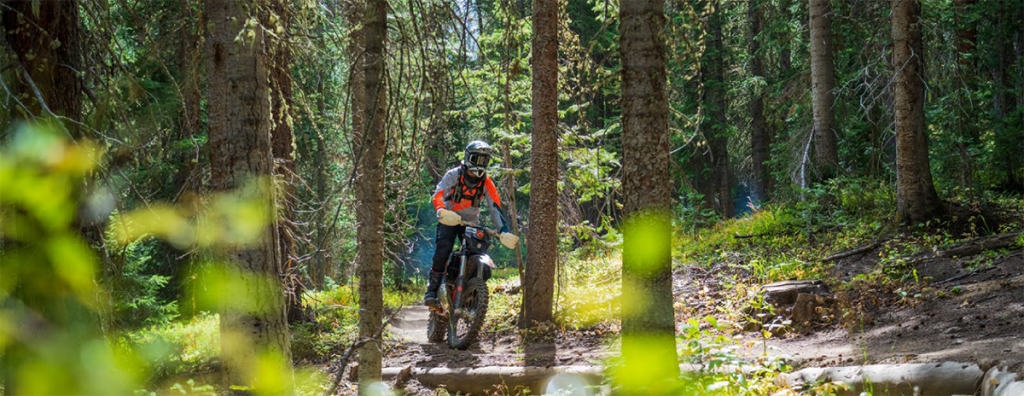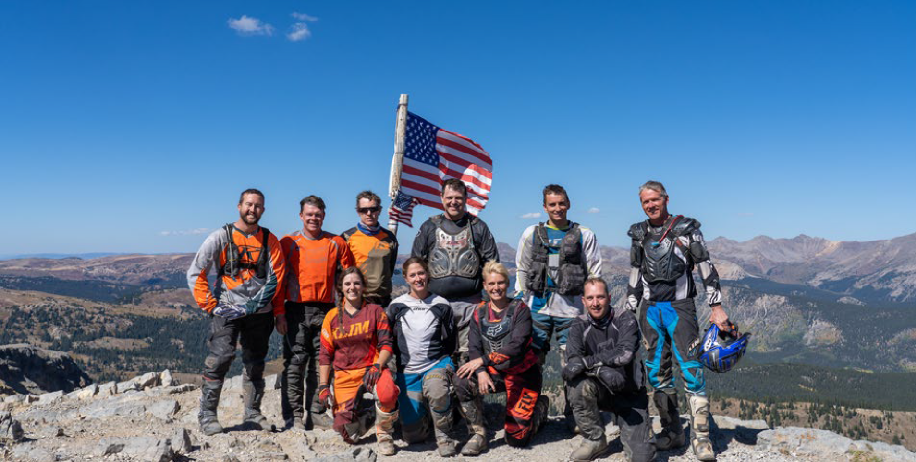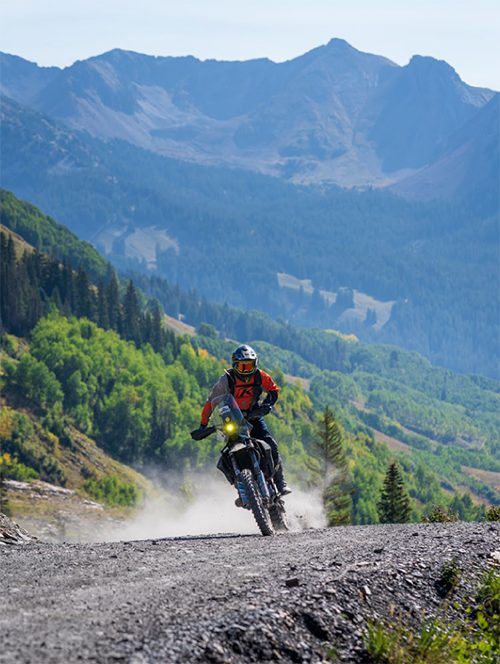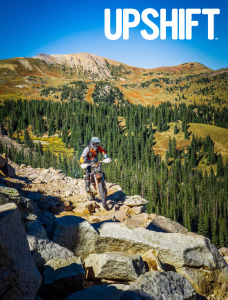This article is republished with permission from UPSHIFT Magazine from their October 2021 issue.
Words and photos: Chad De Alva
Public land is public land. It’s land that should be open to all user groups to recreate on. It doesn’t belong to me any more than it belongs to you – and that is exactly what makes it public. Yet somewhere along the way, the definition of public land seems to have been twisted, and there are legions of folks out there now who don’t want anyone else besides their user group on our public land that we as Americans all own equally. As motorized users of public land, we’re more often than not the first user group to fall under the crosshairs of those who seem to believe that public land is their land and other users are not allowed. Make no mistake about it – there is no shortage of folks out there who would be thrilled to never see a motorcycle on public land again. So the question you need to ask yourself is: do you want to help save our sport?
The Colorado Trails Preservation Alliance (TPA) was created specifically to help save motorcycle riding in Colorado and the surrounding states. This isn’t another localized motorcycle club, but rather a unique non-profit that works to help support local clubs and provide strategic level of support to motorized recreation advocacy efforts across the Western United States. Think of a local motorcycle club as the boots on the ground working at the tactical level and engaging with their specific land managers and local issues. The TPA acts on a more state-wide strategic level, helping new clubs get off the ground or supporting established clubs in their local efforts. The TPA has all of one paid employee, and the rest of the board is all-volunteer, which makes this a very efficient non-profit with a long track record of getting advocacy work done. Just take a look at the news section of their website www.coloradotpa.org, where you can see everything they’ve done for us. With the support of a number of industry partners and like-minded riders, the TPA is an asset to our sport.
One of the ways that the TPA raises awareness on what they are working on is the Colorado 600 Trails Awareness Symposium. This is a five-day riding event and advocacy symposium that was held in Crested Butte, Colorado, for 2021. Here in the middle of the Rocky Mountains, riders at this year’s event got to learn about and experience firsthand exactly what it’s going to take to ensure that motorcycles will get to play in these mountains for years to come.

Crested Butte is known for its non-motorized recreation, which is ironic given that many of the trails that are now non-motorized were originally built by miners and maintained for decades by motorcycles. The mountains and valleys that surround Crested Butte are in large part the purview of the Grand Mesa, Uncompahgre, and Gunnison (GMUG) National Forest, which has built almost no new motorized trails since 2010, despite receiving nearly a million dollars of OHV fund money annually. Yet the same can’t be said for non-motorized trails. The scary part is that the Forest Service is projecting that the recent “COVID Boom” of users will become the new normal user load within the next ten years. The Forest Service is also making no secret of the fact that they do not have enough money to perform all the maintenance the current inventory of trails requires. So expect the current state of blown out and over used trails to become the new normal unless we step up and do something.
The GMUG National Forest is currently going through its first forest planning process in decades. The draft plan is over 1,800 pages long and will impact both summer and winter recreational activities on the forests. Other user groups are currently proposing increasing the amount of nonmotorized area (Wilderness / Roadless Areas) from 49% to 75% with Alternative D of the draft plan. The TPA alone will expend thousands of hours and tens of thousands of dollars advocating for motorized recreation on this forest planning process alone.
Yet to stack the deck even further against motorized users, some ranger districts of certain Colorado National Forests will not sign volunteer agreements with local motorcycle clubs. Without an agreement in place, any volunteer work that a club does to make our public land and public trails better for anyone who uses them doesn’t count in the eyes of the district ranger. Remember that any user group can use a motorized trail, but motorized users have to be on specifically designated motorized trails. Are you motivated to do something to help save our sport yet?
The TPA supporting local clubs is a great example of an effective organizational structure, but we need to step it up to really expand the impact of current motorized advocacy efforts. To take a page from the mountain bikers’ playbook, look at the International Mountain Bike Association (IMBA). This organization has the main IMBA playing quarterback on an international scale, and then all of these local chapters dealing with the specific objectives present in their back yards. It’s an organizational structure that has proven to be very effective.
Motorized advocacy groups are much more splintered. We’ve got NOHVCC, BRC, AMA, and other organizations all of which are vying for funding from the same user base and chasing their own issues and fighting their own battles. Would our advocacy efforts not be much more effective if we all came together under one flag, or at least figured out how to coordinate our efforts?

So what can you as an individual rider do to help save our sport? If you live in a Western state, find a local club and get involved. If you’re one of the many out of staters who travel to ride each year, find out who cares for the trails where you travel to ride and reach out to find out how you can support their efforts. To be clear – just buying an OHV sticker (which you better be doing) is not enough. Whether it’s a donation of time, money, or both, local clubs and advocacy organizations like the TPA need all the help they can get. I can’t think of a better example of the few working tirelessly to benefit the many than Ride With Respect (RWR), which advocates for motorized riding in this little place called Moab, Utah. Ride With Respect is run almost entirely by one guy, yet his backyard is a mecca for OHV use visited by tens of thousands of users each year. So the least you can do is buy RWR a beer next time you’re in town.
Motorized trail advocacy needs our help – because right now is how we as a user group figure out where we are headed in the coming years. In the era of travel management, the strategy has been no net loss of trails, but now is the time to go on offense and work to adopt a strategy of a net gain of motorized trails. That means redesignation of non-motorized trails, reopening closed motorized trails, and the construction of new motorized trails, in addition to much-needed maintenance on existing trails, like those around Crested Butte. A motorized trail can be used by all user groups, which makes it an efficient tool for resource-strapped land managers struggling to meet an increase in trail demand. How effective we are at doing this ultimately depends on us. So now is the time to get involved in shaping the future of our sport.
 The 2021 Colorado 600 Trails Awareness Symposium was a five-day event that provided a perfect window into the current state of motorized trail use in an area that’s slowly being claimed by non-motorized users. Yet all across Colorado this season, I couldn’t shake the feeling that the motorized trails that so many users enjoy are just becoming more and more neglected as time goes on. Our existing trails need maintenance, and as our user group increases in size along with every other user group out there, we need an expanded inventory of motorized trails and more trail maintenance to handle the increase in user demand.
The 2021 Colorado 600 Trails Awareness Symposium was a five-day event that provided a perfect window into the current state of motorized trail use in an area that’s slowly being claimed by non-motorized users. Yet all across Colorado this season, I couldn’t shake the feeling that the motorized trails that so many users enjoy are just becoming more and more neglected as time goes on. Our existing trails need maintenance, and as our user group increases in size along with every other user group out there, we need an expanded inventory of motorized trails and more trail maintenance to handle the increase in user demand.
Take a good look at the photos that accompany this article. These are the exact riding opportunities and trails that we stand to lose if we as riders just sit back and do nothing. Yet, if we step up and get involved, there is no reason we can’t strive to make more trails like this all across the Western United States.
Get involved with a local club, and chip in to support any trails that you travel to use. Motorized users need to care for what we currently have, and we need to get involved with our local clubs and organizations like the TPA to effectively advocate for new riding opportunities all across the Western United States. The Colorado 600 Trails Awareness Symposium is a great way to gain exposure to the advocacy landscape in Colorado and to meet like-minded folks who care about the future of this awesome sport we all enjoy. If more motorcycle riders attended events like the Colorado 600 and got involved in advocacy efforts, the impact that would have on our sport would be profound. For more information on the Colorado Trails Preservation Alliance go to: www.colorado600.org
The TPA wouldn’t be possible without support from the following companies: Rocky Mountain ATV/MC, Motion Pro, Klim, MotoMinded, Texas Sidewinders Motorcycle Club, Billet Racing Products, Elite Motorsports, Centura/St. Anthony Prehospital Services, Doubletake Mirrors, AMA, KTM, Dunlop, Kate’s Real Food, Tomichi Creek Trading Post, Upshift Online, Dave Mungenast Motorsports.

